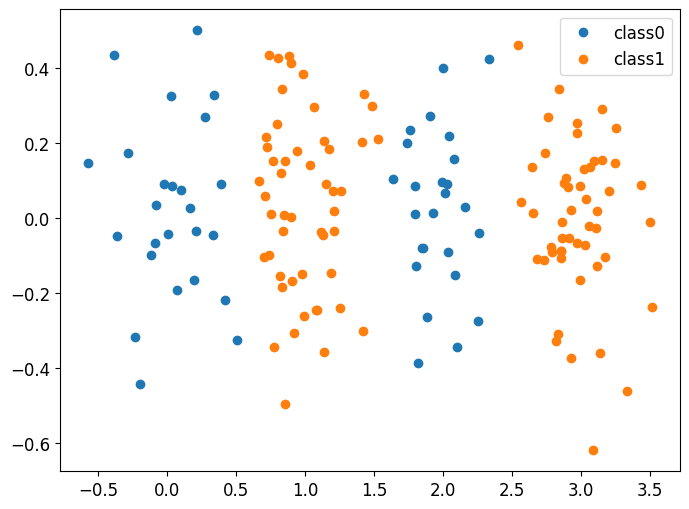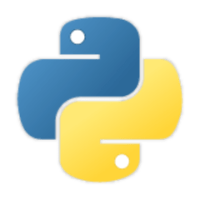💭
任意の確率分布でベイズ分類機を作る
やりたいこと
scikit-learnのnaive_bayesにはいくつかのモデルが実装されていますが、それ以外の確率分布、特にKDEでフィットした経験分布を用いてベイズ分類機を作りたい。
やり方
基本的には以下の通りです。
-
C -
X
任意の形のfitで観測データからパラメータを推定し、pdfで確率(密度)を返します。
分布抽象クラスのAPI
from abc import ABC, abstractmethod
from typing import Self
from nptyping import Float, NDArray, Number, Shape
class Distribution(ABC):
@abstractmethod
def fit(self, X: NDArray[Shape["N, D"], Number]) -> Self:
pass
@abstractmethod
def pdf(self, X: NDArray[Shape["N, D"], Number]) -> NDArray[Shape["N, D"], Float]:
pass
分類機側の実装
上記Distributionを各クラスラベルごとにfitし、predict_probaでBayesの定理でクラス確率を計算します。predictではクラス確率のargmaxを取って最も確率が高いクラスを返します。
from typing import Callable, Self
import numpy as np
from nptyping import Float, Int, NDArray, Number, Shape
from sklearn.base import BaseEstimator, ClassifierMixin
from .distribution import Distribution
class AnyBayesClassifier(BaseEstimator, ClassifierMixin):
def __init__(self, distribution_factory: Callable[[], Distribution]):
self.distribution_factory = distribution_factory
self.dists_: list[Distribution] = []
self.n_classes_: int = 0
def fit(
self, X: NDArray[Shape["N, D"], Number], y: NDArray[Shape["N"], Int]
) -> Self:
self.n_classes_ = max(y) + 1
self.dists_ = []
for class_ in range(self.n_classes_):
mask = y == class_
x = X[mask]
dist = self.distribution_factory().fit(x)
self.dists_.append(dist)
return self
def predict_proba(
self,
X: NDArray[Shape["N, D"], Number],
class_weight: list[float] | float = 1.0,
) -> NDArray[Shape["N, C"], Float]:
if self.n_classes_ == 0:
raise RuntimeError("You must fit the model before predicting")
if isinstance(class_weight, float):
class_weights = [class_weight] * self.n_classes_
else:
if len(class_weight) != self.n_classes_:
raise ValueError(
f"Expected {self.n_classes_} class weights, got {len(class_weight)}"
)
class_weights = class_weight
probs = []
for w, dist in zip(class_weights, self.dists_):
probs.append(dist.pdf(X) * w)
p = np.asarray(probs, dtype=np.float64).T.copy()
return p / p.sum(axis=1, keepdims=True)
def predict(
self,
X: NDArray[Shape["N, D"], Number],
class_weight: list[float] | float = 1.0,
) -> NDArray[Shape["N"], Int]:
probs = self.predict_proba(X, class_weight=class_weight)
return np.argmax(probs, axis=1)
テスト
scikit-learnのKernel Density Estimation(KDE)を利用した経験分布で分類機を作ってみます。
from dataclasses import dataclass
from typing import Any, Literal, Self, TypeAlias
import numpy as np
from nptyping import Float, NDArray, Shape
from sklearn.neighbors import KernelDensity
from ..distribution import Distribution
BandwidthType: TypeAlias = float | Literal["scott", "silverman"]
KernelType: TypeAlias = Literal[
"gaussian", "tophat", "epanechnikov", "exponential", "linear", "cosine"
]
MetricType: TypeAlias = str
MetricParamsType: TypeAlias = dict[str, Any] | None
@dataclass
class SKLearnKDE(Distribution):
bandwidth: BandwidthType = "scott"
kernel: KernelType = "gaussian"
metric: MetricType = "euclidean"
metric_params: MetricParamsType = None
def fit(self, X: NDArray[Shape["N, D"], Float]) -> Self:
self.kde_ = KernelDensity(
bandwidth=self.bandwidth,
kernel=self.kernel,
metric=self.metric,
metric_params=self.metric_params,
).fit(X)
return self
def pdf(self, X: NDArray[Shape["N, D"], Float]) -> NDArray[Shape["N, D"], Float]:
return np.exp(self.kde_.score_samples(X))
これを山が2つあるようなデータで試してみます。
import matplotlib.pyplot as plt
import numpy as np
np.random.seed(0)
m00 = np.array([0, 0])
m01 = np.array([2, 0])
m10 = np.array([1, 0])
m11 = np.array([3, 0])
s = 0.05
x00 = np.random.multivariate_normal(m00, np.eye(2)*s, 25)
x01 = np.random.multivariate_normal(m01, np.eye(2)*s, 25)
x0 = np.vstack((x00, x01))
x10 = np.random.multivariate_normal(m10, np.eye(2)*s, 50)
x11 = np.random.multivariate_normal(m11, np.eye(2)*s, 50)
x1 = np.vstack((x10, x11))
plt.plot(x0[:, 0], x0[:, 1], 'o', label='class0')
plt.plot(x1[:, 0], x1[:, 1], 'o', label='class1')
plt.legend()

まずはscikit-learnのGaussianNBを試してみます。
y0 = np.zeros(x0.shape[0])
y1 = np.ones(x1.shape[0])
X = np.vstack((x0, x1))
y = np.hstack((y0, y1)).astype(int)
from sklearn.naive_bayes import GaussianNB
model = GaussianNB().fit(X, y)
y_pred = model.predict(X)
print(classification_report(y, y_pred))
precision recall f1-score support
0 0.69 0.50 0.58 50
1 0.78 0.89 0.83 100
accuracy 0.76 150
macro avg 0.74 0.70 0.71 150
weighted avg 0.75 0.76 0.75 150
やはり複数の山があるとちょうど入れ替わっているあたりでうまく分類できず、訓練データに対してもスコアが伸びません。次にKDEでもやってみます。
from sklearn.metrics import classification_report
from anybayes import AnyBayesClassifier, IndependentSKLearnKDE
model = AnyBayesClassifier(distribution_factory=IndependentSKLearnKDE).fit(X, y)
y_pred = model.predict(X)
print(classification_report(y, y_pred))
precision recall f1-score support
0 0.98 1.00 0.99 50
1 1.00 0.99 0.99 100
accuracy 0.99 150
macro avg 0.99 0.99 0.99 150
weighted avg 0.99 0.99 0.99 150
訓練データに対する評価ですが、ばっちり分類できています!
今回実装したものはAnyBayesという名前でGitHubに公開しています。


Discussion